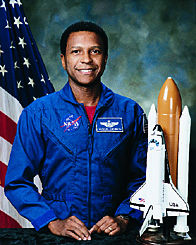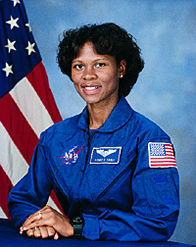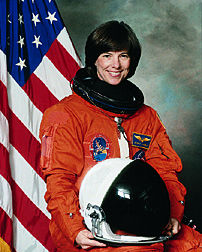
Part Three - Prevention Is Key to UW Effort
UW's research is at the heart of the ultimate in prevention. The institute wants scientists to come up with a "digital human," with the goal of modeling how the body will respond to space flight. Kushmerick is team leader of nine studies, some at UW and some at other institutions, with the title of Integrated Human Function.
While some research areas look at one body system, the integrated human function program takes a more holistic approach. Its goal is nothing less than understanding how the body works, from molecules to entire body systems. Having a digital human would allow researchers to predict potential problems, simulate health conditions and allow researchers to predict problems.

UW alumnus Michael Anderson, '81. Photo courtesy NASA.
"In space, they won't be able to say, 'Oh, I've got an emergency so let's turn back.' We need to know how the body works so that one can anticipate the effect of something without actually doing it," Kushmerick says.
The team is beginning its modeling in studies of cardiac and skeletal muscle. Scientists know that the protein myosin is the main molecular motor of muscle. And scientists know a lot about muscle mechanics and blood flow. What's missing is a solid model of the connections in between.
"We will build a model, from molecules to the larger structure, of the muscle. We want to know what microscopic properties of the internal structure are related to being able to do a certain level of muscle performance," Kushmerick says.
White compares the digital human approach to a famous scene from the movie Apollo 13. The astronauts faced problems removing carbon dioxide after an accident forced them to live in the lunar module. On Earth, engineers dumped out a box of parts that were available to the astronauts and had to come up with a solution. They tested several ideas and found that by using plastic bags, cardboard and tape, they could hook up canisters from the damaged command module to the lunar module's air system.

UW alumna Yvonne Cagle, '85. Photo courtesy NASA.
The 'digital human' would allow scientists to do the same thing with the human body. "The problem on Apollo 13 was solved by people on Earth who had a model of the system to tinker with, and try solutions on. If something goes wrong on a trip to Mars, we will need a model of the human body that we can tinker with, and that will give us realistic responses," White says. "We need something that can take everything we know—all biological and physiological information—and the individual elements of a person."
Kushmerick's group will be in contact with other researchers, at UW and elsewhere, with a similar goal. Many groups making use of information from the Human Genome Project are engaged in digital human projects, hoping to discover the keys to preventing or treating various illnesses.
But prevention can only go so far. The truth is that on a long mission, there is a solid chance that someone could get crushed by a piece of machinery, be diagnosed with cancer, or suffer any number of possible nasty surprises. The space medicine institute has also created the Smart Medical Systems team.
"The astronauts will need to bring a hospital along with them," says UW's Lawrence Crum, principal physicist of the Applied Physics Laboratory, who is one of the team's associate leaders. His group is creating an ultrasound device that would stop internal bleeding, a major cause of death after trauma.

UW alumna Bonnie Dunbar, '71, '75. Photo courtesy NASA.
This machine would be perfectly at home in Capt. Kirk's world. Most of us associate ultrasound with detection and diagnosis. We can see grainy pictures of a baby in the womb, or of a blocked artery. And the UW machine would provide diagnostic images as well. It would use ultrasound to locate, say, the precise location of internal bleeding in a liver.
But then the machine would use an even higher frequency, high intensity sound to generate heat, and cauterize a wound or blast a cancer. It can aim its energy to burn precisely at the spot that needs it, deep within tissues, without damage to the intervening skin and tissues. It would be, in effect, bloodless surgery without the need of an incision. When the machine is tested on a bovine eyeball, you watch as a teardrop-shaped lesion appears as if by magic in the middle of the eyeball, aimed at a precise point. In theory, you could place the machine on the patient. The machine would almost automatically recognize the diseased area and then treat it.
"It's 'point and shoot' surgery," says Michael Bailey, a postdoctoral research scientist in the Applied Physics Lab. "This is Star Trek stuff."
Internal bleeding is a very real risk in space. While gravity is not an issue, nothing has repealed inertia. A heavy piece of machinery could still crush an astronaut's organs. Such accidents also take place on Earth. APL scientists think the machine could also have big benefits on Earth to treat people with certain conditions and who cannot easily reach a doctor.
Go To: Page 1 | Page 2 | Page 3 | Page 4
- Sidebar: From Fiction to Fact: Space Station Alpha
- Return to March 2001 Table of Contents